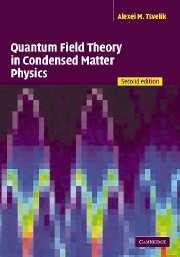Book contents
- Frontmatter
- Contents
- Preface to the first edition
- Preface to the second edition
- Acknowledgements for the first edition
- Acknowledgements for the second edition
- I Introduction to methods
- II Fermions
- III Strongly fluctuating spin systems
- IV Physics in the world of one spatial dimension
- Introduction
- 22 Model of the free bosonic massless scalar field
- 23 Relevant and irrelevant fields
- 24 Kosterlitz–Thouless transition
- 25 Conformal symmetry
- 26 Virasoro algebra
- 27 Differential equations for the correlation functions
- 28 Ising model
- 29 One-dimensional spinless fermions: Tomonaga–Luttinger liquid
- 30 One-dimensional fermions with spin: spin-charge separation
- 31 Kac–Moody algebras: Wess–Zumino–Novikov–Witten model
- 32 Wess–Zumino–Novikov–Witten model in the Lagrangian form: non-Abelian bosonization
- 33 Semiclassical approach to Wess–Zumino–Novikov–Witten models
- 34 Integrable models: dynamical mass generation
- 35 A comparative study of dynamical mass generation in one and three dimensions
- 36 One-dimensional spin liquids: spin ladder and spin S = 1 Heisenberg chain
- 37 Kondo chain
- 38 Gauge fixing in non-Abelian theories: (1 + 1)-dimensional quantum chromodynamics
- Select bibliography
- Index
30 - One-dimensional fermions with spin: spin-charge separation
Published online by Cambridge University Press: 05 May 2010
- Frontmatter
- Contents
- Preface to the first edition
- Preface to the second edition
- Acknowledgements for the first edition
- Acknowledgements for the second edition
- I Introduction to methods
- II Fermions
- III Strongly fluctuating spin systems
- IV Physics in the world of one spatial dimension
- Introduction
- 22 Model of the free bosonic massless scalar field
- 23 Relevant and irrelevant fields
- 24 Kosterlitz–Thouless transition
- 25 Conformal symmetry
- 26 Virasoro algebra
- 27 Differential equations for the correlation functions
- 28 Ising model
- 29 One-dimensional spinless fermions: Tomonaga–Luttinger liquid
- 30 One-dimensional fermions with spin: spin-charge separation
- 31 Kac–Moody algebras: Wess–Zumino–Novikov–Witten model
- 32 Wess–Zumino–Novikov–Witten model in the Lagrangian form: non-Abelian bosonization
- 33 Semiclassical approach to Wess–Zumino–Novikov–Witten models
- 34 Integrable models: dynamical mass generation
- 35 A comparative study of dynamical mass generation in one and three dimensions
- 36 One-dimensional spin liquids: spin ladder and spin S = 1 Heisenberg chain
- 37 Kondo chain
- 38 Gauge fixing in non-Abelian theories: (1 + 1)-dimensional quantum chromodynamics
- Select bibliography
- Index
Summary
The bosonization procedure works equally well for fermions with spin, thus providing us with an essentially nonperturbative approach to one-dimensional metals. The foundations of this approach were laid in the late 1970s and early 1980s by various authors (see the review article by Brazovsky and Kirova (1984) and references therein).
The bosonization approach is based on the fact that coherent excitations in onedimensional interacting systems are not renormalized electrons, but collective excitations – bosons. For spinless fermions there is only one branch of collective excitations – charge density waves. For fermions with spin, another branch appears which represents spin density waves. Elementary excitations in the charge sector carry charge ±e and spin 0; excitations in the spin sector are neutral and carry spin 1/2. Since the different branches have different symmetry properties, one can expect them to have quite different spectra. This can even go to such extremes that one branch has a gap and the other does not. It is only natural under such circumstances that electrons, which carry quantum numbers from both the spin and charge sectors, cannot propagate coherently. Roughly speaking, the parts of the electron containing different degrees try to tear it in pieces; it is customary to call this phenomenon spin-charge separation. Empirically this loss of coherence is revealed as an absence of a quasi-particle pole in the single-electron Green's function, an effect whose existence is supported by experimental observations (see discussion at the end of the chapter).
All phenomenona described above (the spin-charge separation and existence of excitations with fractions of quantum numbers) can be described by the model considered below.
- Type
- Chapter
- Information
- Quantum Field Theory in Condensed Matter Physics , pp. 267 - 276Publisher: Cambridge University PressPrint publication year: 2003

